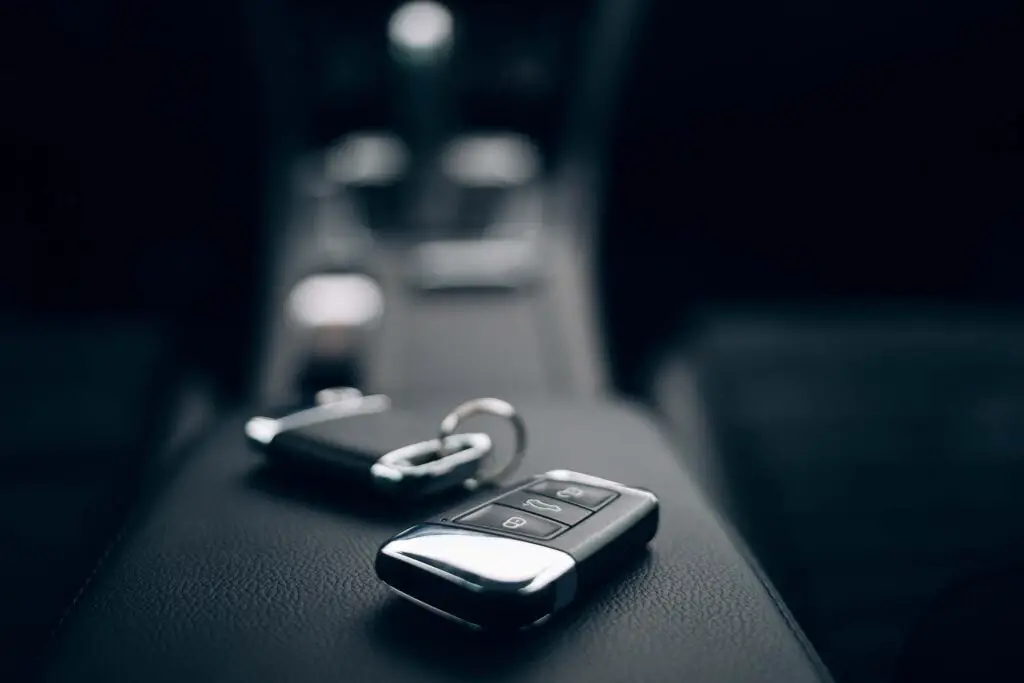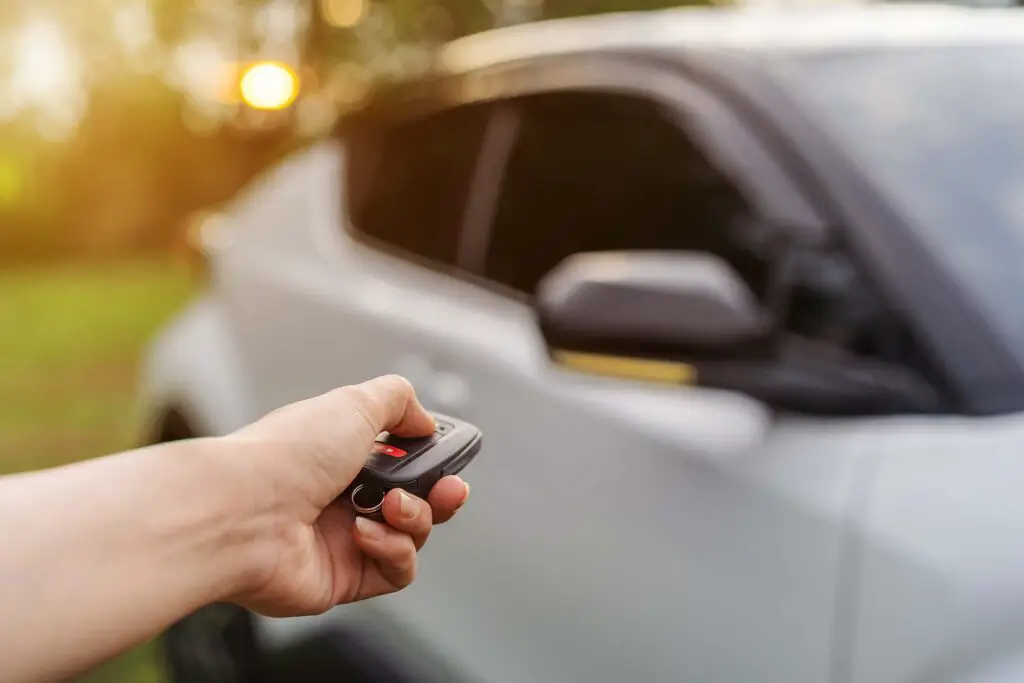Ever found yourself wondering – can a low battery in the key fob cause the car not to start? It’s a valid question, especially when faced with a four-wheeler that refuses to roar to life. So, let’s stop playing the guessing game and take a look at this common problem.
Yes, a depleted power source in the remote can prevent vehicle ignition. This issue arises especially in vehicles with push-button starts, where proximity detection is vital for operation. Furthermore, traditional ignitions with modern features also rely on signal strength from the remote for secure communication. However, certain cars have backup systems, and other reasons unrelated to the fob’s power might also be culprits.
What Is the Role of a Key Fob?
Often referred to as a remote or transmitter, this handy gadget has improved significantly over the years, following the evolution of cars step by step. Initially, its primary role was to simply lock and unlock doors from a distance.
However, born in the era of technological advancements, these transmitters quickly grew in functionality, integrating features like remote start, trunk release, and vehicle location. Overall, the once modest car remote is now integral to modern vehicle security and convenience.
How Key Fobs Communicate With Vehicles?
At the heart of this handy gadget’s function is its ability to communicate with the four-wheeler wirelessly, primarily using radio frequency (RF) signals. When you press a button on your remote, it sends a coded RF signal to your keyless vehicle, instructing it to perform a specific action, be it unlocking the doors or starting the engine.
Modern fobs employ a rolling code mechanism to ensure security. This means every time you press the button, the code changes, making it almost impossible for potential thieves to intercept and duplicate the signal.

How Does a Key Fob Battery Work?
These gadgets are powered by small, button-shaped batteries, commonly known as coin cell batteries. They are typically made from lithium and are specifically designed for electronic devices that require long-lasting, consistent power.
Among the most common batteries used for vehicle remotes are the CR2023, CR2025, and CR2016 batteries. Here’s an overview of their main specifications:
| Type | Voltage | Capacity | Temperature Range | Dimensions |
| CR2023 | 3V | 220-225 mAh | -20°C to +60°C | 0.8 x 0.1 in (20 x 3.2 mm) |
| CR2025 | 3V | 160-165 mAh | -20°C to +60°C | 0.8 x 0.01 in (20 x 2.5 mm) |
| CR2016 | 3V | 90-100 mAh | -20°C to +60°C | 0.8 x 0.06 in (20 x 1.6 mm) |
How Long Does a Key Fob Battery Usually Last?
On average, these batteries serve faithfully for about 3 to 5 years. As they weaken over the years, there’s a gradual decrease in signal strength. This means you might need to be closer to your four-wheeler for the remote to work effectively.
Remember, this is an early indication that it’s on its way out and requires a replacement soon to avoid any inconvenience. So, make sure to address this problem as soon as you start noticing the first signs, as there’s no benefit to trying to stretch its lifespan and wondering – how long does a Honda key fob last on low battery?

What are the Symptoms of a Low Key Fob Battery?
As we just touched upon, one of the earliest indicators of a dwindling battery is the reduced range that requires you to stand closer to your trusted ride for the remote functions to work. However, this is just the tip of the iceberg. Here are other common symptoms of low battery in a key fob:
- Delayed response – you have to press a button multiple times for the desired action,
- Dashboard warnings – some vehicles might flash a warning light or display a message on the dashboard indicating this specific problem,
- A working physical key – the physical portion of the remote smoothly unlocks the door, but the buttons still fail to execute commands,
- Inconsistent operation – on certain days, the remote might function perfectly, while on others, it’s completely unresponsive,
- Complete unresponsiveness – the most obvious and dire symptom is when the remote ceases to function altogether. But it’s also important to ensure it’s not due to external factors like interference or damaged internal components.

Can a Low Battery in the Key Fob Cause the Car Not to Start?
We’ve finally reached the question of the day – will a dead battery in a key fob cause the car not to start? Indeed, weakened or dead batteries can, in specific circumstances, interfere with your vehicle’s ability to start, no matter if you’re driving a small city car or one of those off-road driving giants.
Let’s dive into some common scenarios to shed light on this connection:
Push-To-Start Vehicles
As already mentioned, in vehicles equipped with push-button ignition, proximity is crucial. The four-wheeler detects the remote’s presence nearby, allowing you to start the engine with a simple press of a button. If the power source within the remote is fading, it could hinder this crucial wireless dialogue, causing the vehicle to not recognize its presence. As a result, pressing the ignition switch yields no response, leaving you with a ride that can’t roar to life.
Traditional Turn-Key Ignitions With Modern Security Features
Beyond the contemporary push-button start, even traditional ignition systems have seen modern updates – many of them now contain a transponder chip inside the key.
When you attempt to start the vehicle, this chip communicates wirelessly with it, ensuring the right piece is in the ignition. If the remote’s power is dwindling, this signal might not be strong enough, preventing the four-wheeler from starting even with a traditional ignition system.
Exceptions and Other Factors
Fortunately, automakers anticipate the issues we’ve discussed above. Nowadays, many cars come equipped with systems like physical slots or backup ignition methods to bypass this problem. However, it’s worth noting that a non-responsive vehicle isn’t solely the fault of a weakened remote. Other culprits might include a drained car battery, starter issues, or fuel system problems. So, it’s always advisable to seek professional advice if your four-wheeler remains unresponsive after replacing the remote’s power source.
What to Do if Your Key Fob Battery Is Low or Dead?
The best course of action when faced with a weakened remote? Don’t let procrastination set in or settle for makeshift solutions like using your backup – instead, jump straight to rejuvenating your remote. Here’s a straightforward guide to get you through the whole ordeal:
- Using a flat-head screwdriver or even a coin, gently pry open the small notch or the slider mechanism on the remote,
- Once you open the remote, take note of the specific power cell model, which is typically inscribed on the cell itself,
- Head to a local electronics or auto parts store to buy the appropriate replacement,
- Ensure that the positive side is facing the right direction and put the coin cell in,
- Reassemble the remote and ensure everything fits snugly.
This process is pretty easy and straightforward, but you might notice that your vehicle still doesn’t respond post-replacement. If that’s the case, it might be time to seek expert advice. Sometimes, the issue might be more intricate than just a fading power source, and that’s when a visit to a professional or dealership can provide clarity and a solution.

Tips to Extend Key Fob Battery Life
Proper storage plays a pivotal role in prolonging the life of your remote’s power source. It’s essential to keep it in a cool, dry place, away from direct sunlight or extreme temperatures. Such conditions can lead to a premature power drain or, worse, damage the internal components.
Being aggressive with button presses can also impact the lifespan. Unintentional or excessive pressing, especially when the vehicle is out of range, can cause unnecessary power consumption. Moreover, it’s prudent to rejuvenate the remote with a fresh power cell at regular intervals or when you first notice signs of lagging responsiveness. By adopting these simple habits, you can ensure that your remote remains efficient for longer.

Wrapping Up the Remote Rundown
Navigating the world of vehicle remotes might seem like a minor detail until the day you’re left standing in the rain, pressing a button that stubbornly refuses to respond. Thankfully, with a bit of insight and proactive care, you can easily sidestep such inconveniences. So, next time your trusted ride gives you the silent treatment, you’ll know just what to do. Stay charged and drive on!
Frequently Asked Questions About Low Battery in the Key Fob
How Often Should I Change My Key Fob Battery?
The lifespan of the power source in most remotes hovers around the 3-5 year mark. However, it largely depends on how frequently you use the remote functions. If you notice declining responsiveness or increased inconsistency, it might be time for a refresh.
Can I Replace the Battery Myself, or Do I Need to Visit the Dealership?
Many users find success in switching out the power cell themselves by following manual instructions or online tutorials. That said, if you’re ever in doubt or face difficulties, a professional or dealership can offer expert guidance and ensure everything is done accurately.
Is It Expensive to Replace the Remote’s Power Cell?
Generally, no. Most power cells for remotes are relatively inexpensive. However, costs can vary based on the brand and where you purchase them. For precision and quality, sometimes it’s worth paying a bit more.
Is There a Way to Charge My Key Fob Battery?
Typically, remotes rely on non-rechargeable power sources. Once their energy starts to diminish, it’s not about recharging but rather about replacing them. Some newer models may have rechargeable alternatives, but these are exceptions rather than the norm.
Can the Remote’s Power Source Affect Vehicle Security?
Yes, a weakened power cell can impact security features. If the remote doesn’t communicate effectively, the vehicle’s security measures might not engage or disengage properly. Potentially leaving the vehicle vulnerable or locked down.
How Do I Know if It’s Time to Refresh the Remote?
When the distance required for effective communication between the vehicle and remote shortens, or if functions demand multiple attempts, it’s a clear sign that the power source is nearing its end.
Can External Factors Impact the Remote’s Performance?
Absolutely. Extreme temperatures, both hot and cold, can affect the efficiency of the remote’s power cell. It’s always best to store the remote in temperate conditions to prolong its lifespan.








